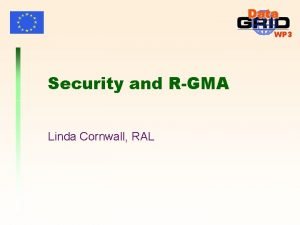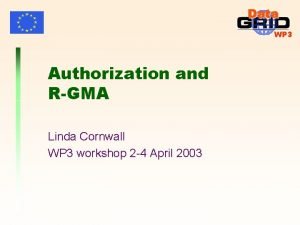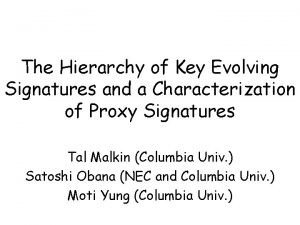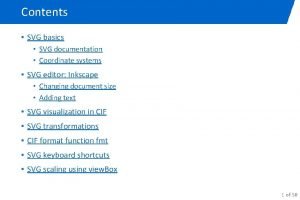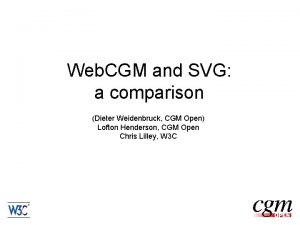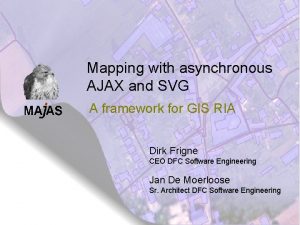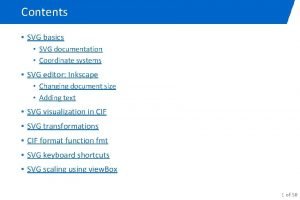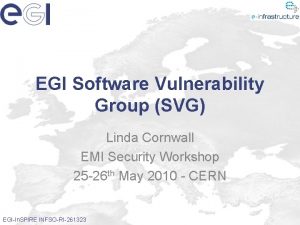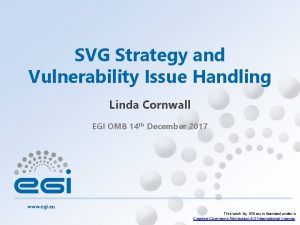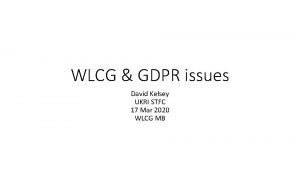Evolving SVG Linda Cornwall STFC UKRI UK HEPSYSMAN
















- Slides: 16

Evolving SVG Linda Cornwall, STFC, UKRI UK HEPSYSMAN May 23 rd 2019 eosc-hub. eu Dissemination level: Public @EOSC_eu EOSC-hub receives funding from the European Union’s Horizon 2020 research and innovation programme under grant agreement No. 777536.

What is SVG? (reminder) SVG = Software Vulnerability Group Main Purpose – to prevent Security Incidents due to software vulnerabilities - In EGI - But NOT trying to substitute/compete with various other vulnerability activities external to EOSC-hub/EGI Been running in current form since 2005 with relatively minor changes including - Going from being focussed on Grid Middleware to all types of software on the EGI distributed infrastructure - Encompassing EGI Fed. Cloud 18/05/2021 2

EGI SVG basic procedure SVG has been handling vulnerabilities since 2005 Handling vulnerabilities which affect the EGI infrastructure and its predecessors - To help prevent security incidents - Anyone may report an issue by e-mail to report-vulnerability@egi. eu If it has not been announced, SVG contacts the software provider and the software provider investigates (with SVG member, reporter, others) If relevant to EGI the risk in the EGI environment is assessed, and put in 1 of 4 categories – ‘Critical’, ‘High’, ‘Moderate’ or ‘Low’ If it has not been fixed, Target Date (TD) for resolution is set - ‘High’ 6 weeks, ‘Moderate’ 4 months, ‘Low’ 1 year Advisory is issued by SVG - If the issue is ‘Critical’ or ‘High’ in the EGI infrastructure When the vulnerability is fixed if EGI SVG is the main handler of vulnerabilities for this software, or software is in EGI Repository regardless of the risk. If we think there is a good reason to issue an advisory to the sites. Critical vulnerabilities are handled with top priority, aiming for a resolution within 1 day https: //documents. egi. eu/public/Show. Document? docid=3145 18/05/2021 3

Why SVG needs to change Proliferation of software and technology used has occurred - The distributed infrastructure is less and less homogenous as time goes on Now including services in the EOSC-hub Catalogue Software Vulnerability Group (SVG) Risk Assessment Team (RAT) cannot be experts in all software, services and configuration - Nor can they be looking out for advisories on all software that may be used Need a new approach - SVG has to hook into the evolving world the best way we can 18/05/2021 4

From meetings… Many sites are saying ‘we are using X software or Y software in such a way to enable our services’ Such people need to think about what software they are using, SVG has a checklist to help https: //wiki. egi. eu/wiki/SVG: Software_Security_Checklist For Services in the EOSC-hub catalogue - The person responsible for the service must be a contact, and/or provide contact(s) who know how those services operate and can help investigate relevant vulnerabilities, and look out for vulnerabilities 18/05/2021 5

To move forwards Need to depend on experts on software and services to assess a vulnerability When a new software vulnerability is reported: - Need to be able to contact the appropriate experts easily § Software developers § Those who set up services which depend on the software - Then set up an Issue Risk Assessment Team (i. RAT) to handle this vulnerability Devised a new procedure – first in April 2018, then revised in November 2018 - Put into Fit. SM format (EOSC-hub using this) - And a diagram 18/05/2021 6

Software Vulnerability Reported Reject PROCEEDURE END Is it a legitimate security issue? ? Re-route if legitimate security issue. PROCEEDURE END Out of all scopes Database of Info contacts on services and software 1. Is it a Software Vulnerability ? Not within scope of services with AUP 2. Is vulnerability in scope of OLA/High integration level services? Is vulnerability in scope of other EOSC-hub services? 3 Set Reporter. Resp deadline. Acknowledge reporter ask if they wish to be credited to respond by Reporter. Resp Forward PROCEEDURE END Subprocess 1 Wait for either response from reporter or Reporter. Resp deadline Reject PROCEEURE END

4. Create i. RAT • Suppliers • Customers • Optionally reporter Database of Info contacts on services and software 5. Assess Risk/impact and collect information on protected working area for this particular vulnerability - Risk for each service - Risk for each infrastructure 6. Create dissemination web page (i. RAT access only initially) Identify mitigation and time to remediation within X hours/days depending on risk: Reporter. Resp 7. Wait subprocess 1 to complete (response or timeout) Add reporter to dissemination web page if requested by reporter Subprocess 2 Engage with Peer security contacts, determine if embargo is in place, determine disclosure date and conditions

8. Set next update deadline (Poll. Update) in i. RAT protected working area Peers/Subprocess 2 9. Wait Subprocess 2 completion 10. Engage with peer customer contact for information dissemination 11. Notify Reporter of Status 12. Confirm embargo release conditions 13 Is software vulnerability resolved? Hold until embargo release conditions Final update and release of dissemination webpage Transfer process responsibility to each affected customer and confirm acceptance Close ticket and send final reporter notice PROCEEDURE END 14. If mitigation or relevant information is available and distributable (no embargo): release dissemination information and inform affected customers 15. If vulnerable software is part of suppliers of software to highly integrated services: follow up with managed software release and deployment management 16. If vulnerability is in software outside of suppliers under management, wait for Poll. UPdate and reconsider expected resolution state 17. Update Protected working area 18. Jump pack to 8.

Main Change Those who are responsible for services look out for relevant vulnerabilities and report them SVG-RAT then finds all relevant people to form the i. RAT does risk investigation and risk assessment, works out how to mitigate. Then advisories on what to do relevant to different services can be made - In many cases just update software So a consistent risk assessment is provided, advice on how to act is produced, but by the i. RAT not SVG-RAT becomes more of a coordinator, less of an investigator, ensures process runs and there is a consistent approach People who are experts in various services help others avoid incidents due to software vulnerabilities via the SVG. 18/05/2021 10

Lots to do! We have identified a fair number of tools and subprocedures to make this work But, the most important ones are determining Scope and forming the i. RAT. 18/05/2021 11

Scope Working out whether issue is in scope Scope defined as "Any software used to enable 'High level Integration' services". - For now (‘high level Integration’ is an EOSC term) It includes EGI UMD/CMD - These are used by services, AND EGI endorses them Probably will include the various collaboration services - And get experts involved who run such services 18/05/2021 12

i. RAT – Issue RAT Concept of the i. RAT – or Issue Risk Assessment Team is the biggest change in the SVG evolution After appropriate experts have been contacted the i. RAT is formed which - Investigates the vulnerability, and the effect of the vulnerability on the various services - Assesses the risk to those services. - Works out how to mitigate the problem, whether update software with a patch or carry out other action - Drafts appropriate notification/advisory Then notification/advisory is sent to the relevant parties defining what actions should be carried out. 18/05/2021 13

Tricky bit How to determine scope and form the i. RAT? For EGI UMD/CMD software – simple to contact the right people For the services, the difficult bits are how to find who to contact and what services are using what software Ideally a database of software used and contacts/experts for all services in EOSC-hub service catalogue - But we don’t have it To start, we could consider service contacts/security contacts from definitive list of services - Except that’s not there yet either Hoping to start with access to a definitive service list, which EOSC-hub is developing 18/05/2021 14

Therefore A long way to go! 18/05/2021 15

Thank you for your attention! Questions? eosc-hub. eu @EOSC_eu

